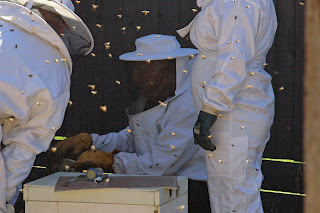I've always been curious about bees. And I especially enjoy honey. Combine those facts with our five acres in a rural area along with our desire to build up a high degree of self-sufficiency and keeping bees seems like a very good idea. Still, it does create a lot of questions:
1. Will I like it?
2. Could I be any good at it?
3. Will it annoy our family/neighbors?
4. Does it add value?
And of course, if I put it to the test of the book, Beautiful and Abundant, Creating the World we Want, I can safely say that:
1. Is it beautiful? Absolutely - bees are incredibly beautiful animals/insects, well organised and industrious
2. Is it abundant? Sure is. You can create 150-200 pounds of honey per hive per year.
3. Is it fair? I believe so as long as one takes good care of the hives
4. Is it contagious? I hope so with respect to our family and friends in the area. They'll certainly get a chance to share in the bounty.
Given all the background, I found a local class here in Melbourne from an organisation called Lifecycle Learning. They teach in an urban area in a community center and have their hives right in the neighborhood. I enrolled in this class well prior to our last trip to the US and it coincides with the end of Winter and beginning of Spring.
We spent a fair amount of time in the classroom, working with the basic elements of a hive, studying the behavior of bees and how to handle them plus the cycle of bees, the seasons, hives and other useful information. Still, I was most looking forward to the practical elements of the class - seeing the hives, seeing how the bees build the brood, process nectar and pollen into honey and do the other "busy bee" activities they do to maintain the hive. The following few slide show the first examination of a hive. Recognise that this is the end of winter here and the hive should be relatively quiet and inactive. In was even marginal as to whether one should open the hive and work with it since the temperature hasn't been too warm. Still, it was relatively warm and certainly, there's a lot of trees and plant in bloom so it looks like Spring is starting.
The following three pictures show the instructor opening the hive and examing the frames.
What we saw was that the bees are really building brood and making honey. All signs that it is Spring. Also, they were making lots of cells for drone eggs - something they typically do in the early Spring as that's when the males are needed to mate with queens.
The following picture is what we saw when we opened the second hive:
Lots and lots of bees in the lid of the box. This means the bees have run out of room, are expanding wherever they can and if this problem isn't resolved quickly, the bees will organize a swarm to get out of the current enclosure and find something larger. Thus, even though it wasn't planned, we set about expanding the hive to insure the bees have plenty of room to expand. This expansion is seen in the next few pictures.
Smoking the hive. This causes the bees to eat a bunch of honey quickly. They don't know if there's a fire that will make them flee but if so, they need to store as much honey as they can to survive the flight. Still, the rapid eating of a bunch of honey causes them to go into a "food coma" resulting in some slow, gentle bees.
Adding the additional box and frames so the bees have plenty of room to expand for the next few weeks.
The final result - building the hive from 2 to 3 boxes only took about 20 minutes and will give the bees adquate expansion room for at least the next few weeks.
So - did I answer my questions from the first part of this blog - definitely yes. I enjoyed this class a great deal and now look forward to the practice of these lessons in an actual "hive day" to be held in a couple of weeks so I get a chance to suit up and work through several different things like finding and marking a queen, merging hives, dealing with bees from a "rescue operation" like getting bees from a possum box, tree or building.






















































